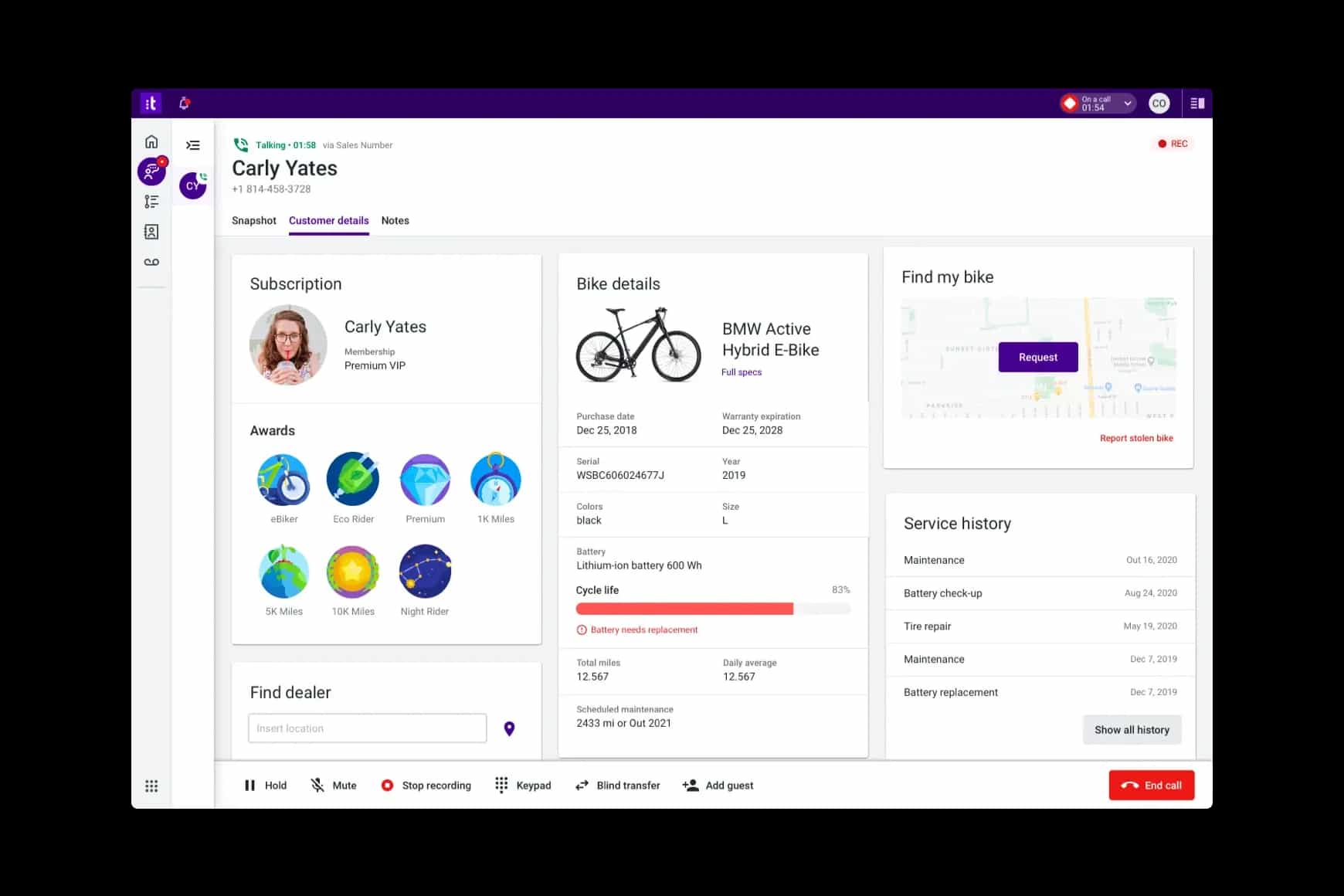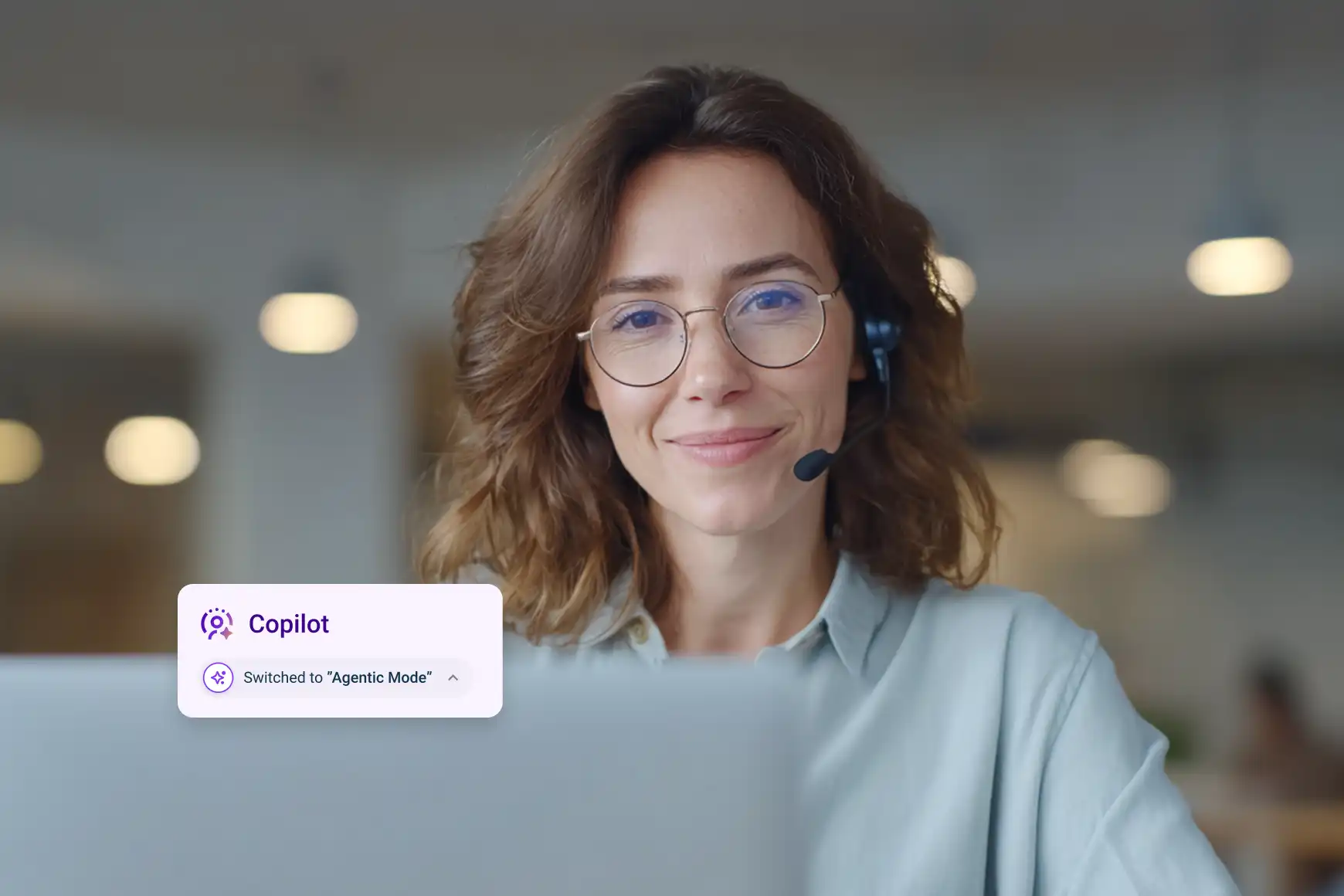What are AI agentic workflows? A comprehensive guide

By Toussaint Celestin
0 min read

Customer experience management is an endeavor that is constantly under pressure to deliver while operating in a fast-paced and demanding environment.
Essential repetitive tasks like data handling, reporting, and support drain time and resources, offsetting the time-saving outcomes they’re designed to enhance. Without the right tools and training, it’s hard to scale customer loyalty-building efforts or focus on what truly matters—customer relationships and business growth.
Imagine if those processes could be automated. AI agents could collect data, process feedback, and create post-interaction notes independently, empowering and liberating human agents to focus on higher priorities.
This is the promise of AI agentic workflows: using AI to handle complex, repetitive tasks with precision and efficiency while introducing a level of autonomous decision-making and task execution previously unavailable with earlier AI-powered solutions.
In this article, we’ll explore what agentic AI workflows are, how they work, and why they’re vital for companies looking to streamline and scale their operations.
What are agentic AI workflows?
Agentic AI workflows are software systems where artificial intelligence takes on tasks traditionally done by humans, operating with a level of autonomy that allows them to complete processes from start to finish. These workflows are powered by advanced technologies like large language models (LLMs), which have transformed how machines understand and generate human-like responses. Think of LLMs as the brains behind many AI workflows—capable of processing vast amounts of data, identifying patterns, and executing tasks with incredible precision.
At their core, agentic AI workflows use algorithms and data processing strategies to simplify complex tasks. For example, they can analyze customer feedback, summarize interactions, and even draft reports without requiring constant human oversight. These workflows aren’t just about saving time; they’re about boosting accuracy and scalability. By automating the repetitive and data-heavy aspects of work, they allow human teams to focus on creative and strategic priorities.
The beauty of agentic AI workflows lies in their flexibility. Whether it’s customer service, sales, or operations, these systems can be tailored to fit specific business needs. LLMs enable workflows to adapt, learn, and improve over time, making them an invaluable asset for companies looking to stay competitive in an increasingly automated world.
What is an AI agent?
Agentic AI workflows are advanced systems in which autonomous AI agents collaborate to manage, make decisions, and execute complex, multi-step tasks with minimal human intervention. Unlike traditional automation—which is limited to a few repetitive, rule-based tasks, or generative AI, which focuses on content creation, agentic AI workflows combine generative capabilities with autonomous action, decision-making, and adaptability to execute and optimize business processes with minimal human oversight.
Agentic AI workflows are powered by intelligent agents that can perceive their environment, analyze information, plan strategies, use tools, and act independently to achieve defined goals. These agents decompose goals into subtasks, use specialized tools as needed, and adapt in real time to feedback or context changes.
Agentic AI workflows represent a leap forward in automation, enabling organizations to optimize operations, reduce manual errors, and scale processes that previously required significant human oversight. By combining generative AI’s creative power with autonomous, adaptive execution, these workflows are transforming industries—from customer service and finance to logistics and healthcare—by automating not just simple tasks, but entire business processes from start to finish.
Powered by a combination of very powerful tools including autonomous AI agents, generative AI (including LLMs), machine learning, NLP, RPA, orchestration platforms, and robust integrations – agentic AI workflows are enabled to not only automate tasks, but also to make autonomous decisions, adapt to changing conditions, and execute actions across diverse business processes. The boon of benefits these powerful applications present to the contact center environment and efficiencies for customer engagement platforms are nothing short of revolutionary.

AI Agents
Unleash the power of agentic AI.
The intelligent decision-making tool that analyzes customer data and automates self-service with a single prompt.
Agentic vs non-agentic workflows: understanding the difference.
To truly appreciate the transformative potential of agentic AI workflows, it’s essential to distinguish them from non-agentic workflows.
Non-agentic workflows are built around simple automation: they execute a fixed sequence of steps with little or no variation, making them reliable and efficient for repetitive, well-defined tasks. These systems operate strictly within predefined rules and require explicit instructions for each action. For example, a traditional car wash always follows the same process, regardless of a car’s unique condition, just as a legacy software system processes every request the same way, regardless of context.
Agentic AI workflows, by contrast, are dynamic and adaptive. They are powered by autonomous AI agents capable of perceiving their environment, reasoning about data, making independent decisions, and taking actions to achieve specific goals—all in real time. Rather than following a rigid script, agentic workflows continuously analyze their context, learn from outcomes, and adjust their behavior to optimize results.
These workflows excel in scenarios that demand intelligence and adaptability, such as customer support, fraud detection, or supply chain optimization, where they can autonomously interpret context, choose the best course of action, and even collaborate with other agents or humans as needed.
For instance, in manufacturing, an agentic workflow might monitor production lines, detect bottlenecks, and proactively adjust schedules or machinery to maintain efficiency. If a machine shows early signs of failure, the AI agent can recommend maintenance or reroute tasks to minimize downtime.
Important components of an AI agentic workflow.
To unlock the potential of AI agentic workflows, it’s essential to break down their key components. These workflows consist of interconnected elements, each serving a critical purpose to ensure smooth operations.
1. Natural language processing (NLP) allows AI agents to respond to human input.
Natural language processing (NLP) is a cornerstone of many AI agentic workflows, enabling AI agents to understand and respond to human input in ways that feel natural and intuitive. With NLP, AI agents can interpret text or spoken language, extracting meaning and context to craft appropriate responses. This capability is particularly powerful in environments where clear and seamless communication is essential.
For instance, in an HR setting, an AI agent equipped with NLP might assist employees by answering policy-related questions or guiding them through complex processes like onboarding. By understanding human language, the agent can provide precise, context-aware answers, reducing confusion and improving user satisfaction. The adaptability of NLP allows AI agents to interact with people on a deeper level, creating a more engaging experience.
2. Robotic process automation (RPA) simplifies the robot management process.
Robotic process automation (RPA) plays a crucial role in supporting AI agentic workflows by creating and managing software robots that mimic human actions. These robots are designed to handle repetitive, time-consuming tasks, allowing AI and human agents to focus on higher-value activities. RPA simplifies the management of these robots, ensuring they perform tasks accurately and efficiently.
For example, consider a contact center where RPA is used to perform data entry tasks. After a customer interaction, an RPA bot can automatically populate post-interaction forms with details from the conversation. This process eliminates the need for agents to manually enter data, freeing them up to engage with more customers and focus on providing personalized support.
3. Workflow orchestration defines actions, dependencies, and requirements for each workflow.
Workflow orchestration is the backbone of agentic AI workflows, streamlining each stage by defining actions, dependencies, and requirements. This ensures that every task is executed in the correct sequence, with resources allocated and potential bottlenecks minimized. However, the power of agentic AI goes much further.
Instead of simple workflow orchestration, imagine a master agent responsible for directing a team of specialized AI agents. In a contact center, this could mean one agent handling customer intent detection, another retrieving account history, and a third drafting a personalized resolution—all coordinated seamlessly in real time. Rather than just screening calls, this multi-agent system can preemptively resolve common issues, escalate complex cases with full context, and optimize agent handoffs.
How do agentic AI workflows work?
AI agentic workflows are dynamic systems that seamlessly integrate AI capabilities to optimize and automate complex processes. Here’s a closer look at how they work:
-
Continuous improvement. AI agents constantly analyze their performance, learning from successes and mistakes to refine their processes and get better over time.
-
Memory. They retain key details from past interactions, so they can use context to make smarter decisions in the future.
-
Independent decision-making. AI agents can process real-time data and autonomously choose the best action to achieve their goals without waiting for human input.
-
Human collaboration. These workflows are designed to work side-by-side with people, blending human expertise with AI efficiency to create a more powerful and cohesive team.
With these capabilities, AI agentic workflows automate repetitive tasks and enable businesses to adapt and thrive in changing environments. Next, let’s explore how workflows function differently when powered by single agents versus multiple agents.
Understanding single-agent and multi-agent workflows.
AI agentic workflows can function in two primary ways: using a single agent or leveraging multiple agents. Each approach has its strengths, depending on the complexity of the tasks involved. Here’s a breakdown of how they differ:
-
Single-agent workflows. These workflows are powered by one AI agent, which takes on all tasks from start to finish. Single-agent workflows are ideal for straightforward processes that don’t require collaboration. For example, an AI agent might handle appointment scheduling—managing calendars, sending reminders, and adjusting dates based on availability. Everything runs smoothly because one agent is fully in control.
-
Multi-agent workflows. These workflows involve several AI agents working together, each specializing in different parts of the process. Multi-agent workflows shine in complex scenarios where tasks are interconnected. For instance, in supply chain management, one agent might track inventory levels, while another manages logistics, and a third ensures compliance with regulations. The agents communicate and coordinate via a single controller or master agent to keep the entire workflow running efficiently.
Benefits to agentic AI workflows.
Let’s break down the key benefits of agentic AI workflows and how they impact modern organizations.
Achieve a new level of efficiency.
Agentic AI workflows take efficiency to a new level by handling repetitive tasks and efficiently executing complex processes. Instead of relying on rigid automation, AI adapts and learns, making operations smoother and faster over time. This frees employees to focus on meaningful, strategic work while AI handles busy work like data entry or generating reports.
AI also helps teams work better by connecting systems and sharing real-time information across departments. For example, it can track project deadlines, assign tasks, and adjust priorities automatically. The result? Less chaos, more productivity, and a company that runs like a well-oiled machine.
Make decisions that improve customer engagement.
These workflows might work behind the scenes, but their impact on customer engagements is substantial. By improving accuracy and speeding up operations, they help businesses deliver products and services more reliably. For example, in industries like retail, AI-powered inventory management ensures that popular items are always in stock, preventing customer frustration. Similarly, in customer service, AI workflows can empower support teams by providing real-time insights into customer issues, allowing for faster resolution times and personalized interactions.
Even when operating behind the scenes, agentic AI workflows contribute to a smoother, more enjoyable customer journey. Consider a logistics company using AI to optimize delivery routes by evaluating multiple factors such as traffic, weather, and driver availability. While customers may not see the complex internal algorithms at work, they benefit directly from faster shipping times and fewer delivery delays.
Scale internal workflows beyond human capabilities.
Agentic AI lets businesses scale operations in ways people alone just can’t. Unlike humans, who are constrained by time, cognitive limits, and physical resources, AI can process vast amounts of data in real time, execute thousands of tasks simultaneously, and operate 24/7 without fatigue. This scalability is particularly valuable in areas like fraud detection, where AI can analyze millions of transactions per second, identifying suspicious patterns that would take humans days—or even weeks—to uncover.
Plus, AI workflows excel in handling exponential growth. As businesses expand, processes that once worked at a small scale often become unmanageable. Agentic AI workflows adapt to these challenges by reallocating resources, automating more tasks, and optimizing workflows based on incoming data. For example, continuing with our logistics example above, AI can adjust to changing business conditions in real time. If demand spikes or supply chain disruptions occur, AI agents can instantly adjust schedules, reroute shipments, or allocate resources to maintain efficiency and service quality.
Create integrated workflows between human and AI agents.
AI agentic workflows shine when humans and AI agents collaborate as part of an integrated team. Multi-agent workflows take this a step further by allowing multiple AI systems to work together, while still interacting with human teammates. These workflows assign tasks based on strengths: humans bring creativity, judgment, and empathy, while AI handles data-heavy, repetitive, or highly complex calculations.
For example, in a marketing team, AI agents can analyze customer behavior and predict trends, while humans use that insight to craft compelling campaigns. Multi-agent workflows can even enhance collaboration, with one AI agent generating insights, another optimizing budget, and the team making informed decisions based on these inputs. This partnership allows organizations to move faster and make better decisions.
Top use cases for agentic AI workflows.
Take a look at some of the most impactful use cases where agentic AI workflows are expediting business processes and delivering measurable results:
-
Cybersecurity. AI workflows can monitor vast networks in real time, detect potential threats, and respond automatically to mitigate risks before they escalate.
-
Software development. Agentic AI can automate testing, optimize code, and streamline DevOps pipelines, helping teams deliver high-quality software faster.
-
Human resources. From screening resumes to onboarding new hires, AI workflows speed up HR processes and ensure a consistent and fair candidate experience.
-
Retail. AI can manage inventory, forecast demand, and personalize marketing campaigns, helping retailers stay competitive and meet customer expectations.
-
Healthcare. Agentic AI assists with diagnostics, patient monitoring, and operational tasks like scheduling, enabling healthcare providers to focus more on patient care.
-
Finance. AI workflows power fraud detection, automate compliance checks, and optimize financial planning, ensuring better accuracy and faster decision-making.
No matter the industry, AI agentic workflows improve the customer experience by creating seamless interactions, personalized services, and faster resolutions. Additionally, advanced tools like conversational self-service chatbots and AI-powered assistants ensure that customers get immediate, accurate support.
Leverage agentic AI workflows to streamline your customer experience.
Investing in agentic AI workflows is one of the most meaningful ways to show your customers you care. These tools help boost customer satisfaction (CSAT), reduce customer effort score (CES), and increase net promoter score (NPS), ensuring your business stands out at every step of the journey, from first contact to follow-up. It’s not just about keeping up; it’s about setting the standard for what exceptional customer experience should look like.
Take ServiceTitan, for example—a cloud-based software platform that empowers contractors to manage every aspect of their business. By leveraging Talkdesk CX Cloud™ and its Salesforce integration, ServiceTitan transformed how they serve their customers. Since implementing Talkdesk, ServiceTitan has achieved first contact resolution (FCR) stats above the industry standard range of 70-79%, reduced the average time to answer by seven minutes, and decreased average handle time (AHT) by an additional minute—all while containing live agent call escalations. The result? Happier customers and a more efficient team.
Why wait to elevate your customer experience? Explore how Talkdesk can help you unlock the power of agentic AI workflows and revolutionize the way you connect with your customers.
AI agentic workflow FAQs.
An agentic AI workflow is a dynamic, autonomous, adaptive process in which AI agents independently plan, make decisions, and execute actions to achieve specific goals with minimal human intervention. Unlike traditional workflows, where tasks follow rigid, pre-defined steps, agentic AI workflows are adaptive and capable of responding to real-time data, changing conditions, and evolving objectives.
Agentic AI workflows are important because they allow businesses to operate faster, scale more effectively, manage complex tasks, and deliver better results. They free up human teams to focus on high-value tasks while AI handles repetitive, data-driven, or complex processes.
Agentic AI workflows are incredibly versatile with the ability to streamline processes and drive efficiency across industries as well as execute actions or deliver proactive information automatically to supervisors and administrators. Within customer experience platforms, AI agents excel at tasks like intelligent call routing, predictive analytics, and proactive agent monitoring and quality administration support. For example, they can instantly connect customers to the right agent, reduce response times, and boost key performance indicators like CSAT and FCR.
Overall, agentic AI workflows offer greater efficiency, better decision-making, and enhanced scalability. They improve customer service outcomes, reduce operational bottlenecks, and create personalized, seamless experiences for customers and employees.
In customer service, AI agentic workflows can help many industries in various ways. In finance, they detect fraud and automate compliance checks. In healthcare, they assist with patient scheduling and diagnostics. Retail businesses use them for inventory management and personalized marketing, while in cybersecurity, they monitor networks and respond to threats in real-time.







